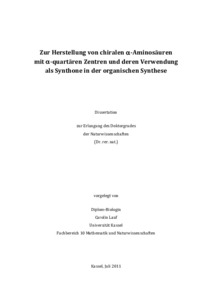| dc.date.accessioned | 2011-10-12T12:23:14Z | |
| dc.date.available | 2011-10-12T12:23:14Z | |
| dc.date.issued | 2011-10-12 | |
| dc.identifier.uri | urn:nbn:de:hebis:34-2011101239387 | |
| dc.identifier.uri | http://hdl.handle.net/123456789/2011101239387 | |
| dc.description.sponsorship | Universität Kassel | ger |
| dc.language.iso | ger | |
| dc.rights | Urheberrechtlich geschützt | |
| dc.rights.uri | https://rightsstatements.org/page/InC/1.0/ | |
| dc.subject | alpha-Methylserin | ger |
| dc.subject | alpha-Methyl-alpha-aminosäure | ger |
| dc.subject.ddc | 500 | |
| dc.title | Zur Herstellung von chiralen α-Aminosäuren mit α-quartären Zentren und deren Verwendung als Synthone in der organischen Synthese | ger |
| dc.type | Dissertation | |
| dcterms.abstract | Ziel dieser Arbeit war, ausgehend von alpha-Aminoaldehyden eine kurze und effiziente Synthese zur Darstellung von Aminosäuren mit alpha-quartären Zentren in enantiomerenreiner Form und davon ableitbare wichtige Synthone in der organischen Synthese zu entwickeln. Der enantiomerenreine 2-tert-Butyl-4-methyl-1,3-oxazolidin-4-carbaldehyd ist via kupfer-katalysierter Aziridinierung des enantiomerenangereicherten 2-tert-Butyl-5-methyl-4H-1,3-dioxins mit der Nitrenquelle (N-Tosylimino)phenyliodinan zugänglich. Eine anschließende Oxidation mit Natriumhyperchlorid und Wasserstoffperoxid führt zur korrespondierenden Carbonsäure, die via sauer katalysierter Acetalspaltung und nachfolgender Abspaltung der Tosyl-Schutzgruppe in enantiomerenreines alpha-Methylserin in sehr guten Ausbeuten umgewandelt werden kann. Mit dem Einsatz von in C5-Position Ethyl-substituiertem 2-tert-Butyl-4H-1,3-dioxin ist analog das N-Tosyl geschützte alpha-Ethylserin darstellbar. Um die bestehende Lösungsmittelabhängigkeit in weniger polaren Losungsmitteln wie Dichlormethan oder Diethylether der Aziridinierung in Bezug auf ihre Diastereoselektivität und Reaktivität zu minimieren, wurden unterschiedliche Nitrenquellen untersucht. [N-(p-Methoxybenzolsulfonyl)imino]methoxyphenyliodinan stellte sich als die potenteste Nitrenquelle heraus und die Ausbeute konnte auf bis zu 70% gesteigert werden. Die Anwendbarkeit des N-Tosyl geschützten alpha-Methylserins konnte mit der Synthese des β-Lactons und 2-Carboxylethylether-2-aziridin unter Mitsunobu-Bedingungen gezeigt werden. Dabei ist die Reaktion durch einfache Variation des Lösungsmittels und der Reaktionstemperatur zu beiden Produkten in sehr guten Ausbeuten hin steuerbar. Das β-Lacton konnte anschließend erfolgreich in das N-Tosyl- und S-Acetyl- geschützte alpha-Methylcystein überführt werden. | ger |
| dcterms.abstract | The aim of this dissertation was to develop a short and efficient method for the synthesis of enantiomerically pure amino acids bearing a quaternary chiral center starting with amino aldehydes. The enantiomerically pure 2-tert-butyl-4-methyl-3-(toluene-4-sulfonyl)-1,3-oxazolidine-4-carbaldehyde is readily available by metal-induced aziridination of enantiomerically enriched 2-tert-butyl-5-methyl-4H-1,3-dioxin with nitrenes generated from (N-tosylimino)phenyliodinane. The oxidation with sodium hyperchloride and hydrogen peroxide leads to the corresponding carboxylic acid, which can be transformed via acid catalyzed acetal cleavage and following elimination of the tosyl protecting group into the enantiomerically pure alpha-methylserine in good yields. With the use of in C5-position ethyl substituted 2-tert-butyl-4H-1,3-dioxin the N-tosyl protected alpha-ethylserine is analogously prepared. The aziridination depends on the polarity of the solvent and good selectiviies and reactivity can be obtained with less polar solvent as dichlormethane or diethyl ether. Different nitrenes have been investigated to decrease the dependence on the solvent. [N-(p-methoxybenzenesulfonyl)imino]methoxyphenyliodinane appeared to be the most potent nitrene and the yield was increased to 70%. The applicability of the N-tosyl protected alpha-methylserine was demonstrated with the synthesis of β-lactone and 2-carboxyethyl ether 2-aziridine under Mitsunobu conditions. The reaction is simply directed to both products in good yields by variation of the reaction temperature and solvent. Subsequently the β-lactone was successfully transformed into the N-tosyl and S-acetyl alpha-methylcysteine. | eng |
| dcterms.accessRights | open access | |
| dcterms.creator | Lauf, Carolin | |
| dc.contributor.corporatename | Kassel, Universität Kassel, FB 10, Abteilung Organische Chemie | |
| dc.contributor.referee | Frauenrath, Herbert (Prof. Dr.) | |
| dc.contributor.referee | Follmann, Hartmut (Prof. Dr.) | |
| dc.subject.swd | Synthon | ger |
| dc.subject.swd | Organische Synthese | ger |
| dc.date.examination | 2011-08-30 | |

